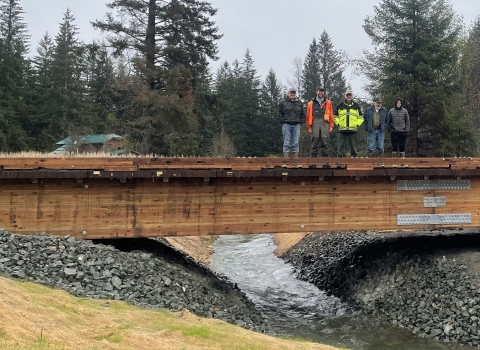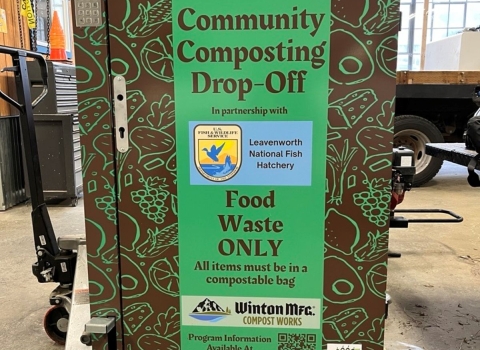Seven generations — 250 years — that is how long the Bowen family has been tied to their land in Virginia.
In the 1760s, Bowen family ancestors settled next to Maiden Spring, where water still bubbles out from underground, forming a creek that flows near the Bowen property and into the Little River, a major tributary of the Clinch River. Somewhere between 1818 and 1834, the Little River was dammed and a five-story mill erected to process many types of grain farmed on the settlement. While the impressive mill was eventually torn down, the 130-foot-wide, 14-foot-tall dam remained.
A river of life
Generation after generation has grown up with a wall of large stones and concrete spanning the width of the Little River, unaware of the environmental impacts of such an obstruction. When U.S. Fish and Wildlife Service biologist Corey Kanuckel approached the three Bowen brothers, who still operate a family farm at Maiden Spring, they were surprised to hear about the abundance of life the river and spring supported.
The Clinch River watershed stands out as one of North America's most ecologically significant and biologically diverse freshwater systems. Hosting a staggering array of aquatic life, it is home to 100 species of fish — five of which are considered threatened or endangered. Additionally, the watershed boasts 46 species of freshwater mussel — with 20 classified as endangered. The river sustains the highest concentration of federally protected species in the United States.
Kanuckel, who works for the Partners for Fish and Wildlife office in Virginia, viewed the dam from a conservation perspective and sought common ground between the Service and the Bowen family. He was instrumental in striking a deal that benefitted everyone, including many aquatic species that call the Bowen property home. However, he wasn’t the first to see the value of the space.
Wildlife hazard and human liability
The Bowens have done their best to be good stewards of their land, taking it upon themselves to plant native trees near the water and install fencing to keep their cattle out of the river. “We’ve always tried to do what’s good for the environment,” said Rees Bowen. His brother Tom excitedly notes that he has seen deer, coyotes and “even golden eagles” on the property. The brothers didn’t know, however, that several fish and mussel species were thwarted by the unused dam.
Kanuckel explained the volume of critters negatively affected by the barrier, including at-risk mussel species, Cumberland moccasinshell and Tennessee clubshell; listed species like slabside pearlymussel; and Tennessee pigtoe, which is proposed to be added to the endangered species list.
Service biologists surveying the river noted that zero mussels were present in the channel above the dam or within 200 meters from its base, which signaled that mussels and their host fish were essentially “knocking on the door” hoping to be let through. With the dam gone, biologists like Kanuckel fully expect to see mussel species in areas they haven’t been capable of reaching for 200 years!
With the promise that work would be completed, leaving the property in even better condition, and that taking the dam out would eliminate a hazard and liability while also benefitting wildlife, the brothers agreed to work with the Service and remove the dam. Additionally, the Service provided the Bowens gravel to stabilize heavy-use areas on the property, keeping farm lanes accessible and reducing sediment runoff from upland areas.
Common ground for conservation goals
Willing landowners are huge allies in fish passage fish passage
Fish passage is the ability of fish or other aquatic species to move freely throughout their life to find food, reproduce, and complete their natural migration cycles. Millions of barriers to fish passage across the country are fragmenting habitat and leading to species declines. The U.S. Fish and Wildlife Service's National Fish Passage Program is working to reconnect watersheds to benefit both wildlife and people.
Learn more about fish passage restoration work benefitting fish, wildlife and people. This project wouldn’t be possible without voluntary participation in conservation and restoration. The private landowner is the steward in this relationship, and the Service’s goal is to look for mutual benefits in any given restoration project.
“We believe in the common ground where agricultural production and wildlife conservation overlap,” said Kanuckel. “Without the participation of willing, private landowners and land stewards, like the Bowen family, we can’t expect to restore these systems on a landscape scale, leading to the recovery of imperiled species.”
Service fish and wildlife conservation offices help secure funding for a variety of projects — like this dam removal. They work with landowners and partners, as well as other Service staff, to ensure that project work is prioritized efficiently and provides the most effective results to fish, wildlife and people. Additionally, Service staff identify and develop beneficial projects, assist with implementation, and provide administrative support. Through the National Fish Passage Program, which received funding through the Bipartisan Infrastructure Law Bipartisan Infrastructure Law
The Bipartisan Infrastructure Law (BIL) is a once-in-a-generation investment in the nation’s infrastructure and economic competitiveness. We were directly appropriated $455 million over five years in BIL funds for programs related to the President’s America the Beautiful initiative.
Learn more about Bipartisan Infrastructure Law , project proposals from across the country are submitted and evaluated. Canaan Valley Institute was awarded $200,000 through the NFPP for the Little River Dam removal project.
Because of this coordination, collaboration and critical funding, the Little River Dam removal is complete — opening 30 miles of stream — already resulting in promising mussel bed development downstream! Bank stabilization has begun, and the project should be completed in the summer of 2024.
Call to action
Do you have a barrier to fish on your property?
Identify and contact your local U.S. Fish and Wildlife Service Partners for Fish & Wildlife Program office or Fish and Wildlife Conservation Office. The Partners Program is the Service's private lands restoration program, with a reputation for engaging partners and landowners within their own communities. Fish and Wildlife Conservation Offices manage the National Fish Passage Program, which provides technical and financial support for barrier removal projects. Local support from private landowners is one of the most important and effective resources in the conservation effort nationwide.








